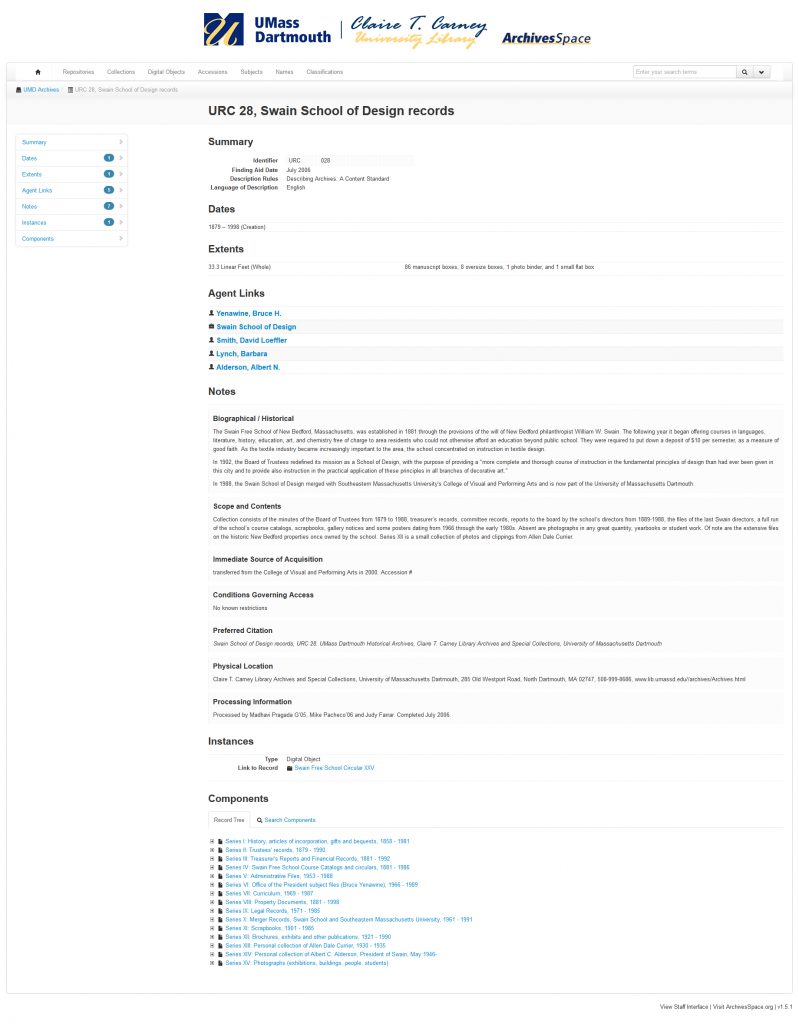 As a graduate student from Simmons College in the archival track of the Library and Information Sciences program, I completed a semester long internship at the Claire T. Carney Library Archives and Special Collections at the University of Massachusetts Dartmouth. The focus of my internship was creating more functional and searchable digital records for 28 university collections through the archives management system ArchivesSpace. Most of these collections were university records that document how faculty, staff and students contributed to the history of the University of Massachusetts Dartmouth and connected universities such as the Swain School of Design. However, a few manuscript collections, namely the Robert F. Kennedy Assassination Archives Records, were also processed as digital records during the semester.
As a graduate student from Simmons College in the archival track of the Library and Information Sciences program, I completed a semester long internship at the Claire T. Carney Library Archives and Special Collections at the University of Massachusetts Dartmouth. The focus of my internship was creating more functional and searchable digital records for 28 university collections through the archives management system ArchivesSpace. Most of these collections were university records that document how faculty, staff and students contributed to the history of the University of Massachusetts Dartmouth and connected universities such as the Swain School of Design. However, a few manuscript collections, namely the Robert F. Kennedy Assassination Archives Records, were also processed as digital records during the semester.

These digital records make it easier for university archivists to search for collections, series, box locations and container types and identify similarities between collections through the proper metadata. Knowing the exact size of a specific box is significant for storage. Some types of boxes such as flat boxes, which are horizontal and often contain oversized materials like maps, calendars and posters, come in many different widths, heights and depths. The addition of unique barcodes to the physical containers and map drawers will also facilitate findability and organization of these materials. In the future, the archivist might even know what materials are in use and what materials are in storage.
Digital efforts and projects by the Claire T. Carney Library Archives and Special Collections are not new to the institution as seen by the digital archives and the digital objects like early twentieth century Swain School catalogs found on the Internet Archive (http://www.archive.org). As well, there are digital scans of the paper finding aids on the archives website (http://www.lib.umassd.edu/archives/). While these finding aids are useful, they do not take full advantage of their digital nature. On the other hand, the finding aids created by ArchivesSpace contain a hyperlinked table of contents that allow users to find information quicker. For instance, with the Swain School of Design records, you might be interested in the merger records that combined that school with Southeastern Massachusetts University. With the previous finding aids, you would either have to scan a thirty-two page document, know what you are looking for or search by keywords. Additionally, the structure of creating the digital records helps remove the idiosyncratic nature of finding aids created at different times by different individuals through the creation of a uniform framework that requires certain elements in certain places. In addition, the digital objects listed above can be linked to directly within the finding aid. Like most aspects of this project, this linkage allows the archive to be more streamlined, centralized and organized in presenting its collections to its users.
–David Boerman, Simmons College School of Library and Information Science
Archivists’ Note: The project to implement ArchivesSpace began with UMass Dartmouth graduate student Jay Patel in 2016. Of over 300 finding aids, 108 have been entered in the ArchivesSpace database. In June there will be a public interface released, which we hope to offer to patrons sometime soon after. Data entry continues with one of our current student assistants, Karen Stubblefield.Built for archives by archivists, ArchivesSpace is the open source archives information management application for managing and providing web access to archives, manuscripts and digital objects.

